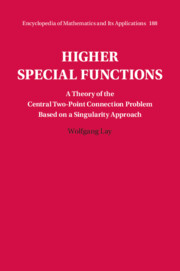 Higher Special Functions
Higher Special Functions Book contents
- Frontmatter
- Dedication
- Contents
- Preface
- Acknowledgements
- 1 Introduction
- 2 Singularities in Action
- 3 Fuchsian Differential Equations: The Cornerstones
- 4 Central Two-Point Connection Problems and Higher Special Functions
- 5 Applications and Examples
- 6 Afterword
- Appendix A Standard Central Two-Point Connection Problem
- Appendix B Curriculum Vitae of George Cecil Jaffé
- References
- Index
5 - Applications and Examples
Published online by Cambridge University Press: 16 May 2024
- Frontmatter
- Dedication
- Contents
- Preface
- Acknowledgements
- 1 Introduction
- 2 Singularities in Action
- 3 Fuchsian Differential Equations: The Cornerstones
- 4 Central Two-Point Connection Problems and Higher Special Functions
- 5 Applications and Examples
- 6 Afterword
- Appendix A Standard Central Two-Point Connection Problem
- Appendix B Curriculum Vitae of George Cecil Jaffé
- References
- Index
Summary
We now present examples of higher special functions. Since not all details are contained in the theoretical discussions of the field, it is these examples that mostly contribute to enable the reader to treat self-reliantly his or her concrete problem. Starting from the question of whether nature is linear or non-linear, the answer is not unambiguous. For weather phenomena, the underlying dynamics is undoubtedly non-linear. However, in the world of atoms and elementary particles, the processes become fundamentally linear. Mathematically, this is expressed by the fact that the underlying differential equation (the so-called Schrödinger equation) becomes linear in nature as soon as atomic processes are described. Hence, a substantial part of the examples here are devoted to solving boundary eigenvalue problems of the Schrödinger equation, the fundamental differential equation in the description of microscopic nature (quantum theory). The aim is autonomy to create new special functions by applying the methods developed. There may well be as yet unseen aspects, a variety of hitherto unknown special functions or even mathematically relevant new discoveries in the field.
Keywords
Information
- Type
- Chapter
- Information
- Higher Special FunctionsA Theory of the Central Two-Point Connection Problem Based on a Singularity Approach, pp. 190 - 274Publisher: Cambridge University PressPrint publication year: 2024